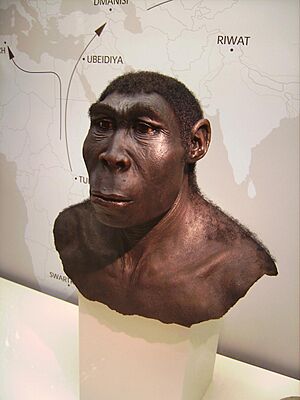Control of fire by early humans facts for kids
When early humans learned to control fire, it was a huge step for their way of life. Fire allowed them to cook food, stay warm, and protect themselves. It also meant they could be active after dark. Fire offered some safety from predators and insects.
Cooking food was probably the most helpful use of fire. Some foods, like meat and certain fruits, can be eaten raw. But others, such as root vegetables, usually need cooking.
We don't know exactly when humans first controlled fire. Experts believe it happened anywhere from 230,000 years ago to 1.5 million years ago. Most scientists agree that Homo erectus used fire about 400,000 years ago.
Contents
Where We Found Fire Evidence
Scientists have found signs of early human fire use at many archaeological sites. These sites are mostly in East and Southern Africa.
Fire Evidence in East Africa
The oldest signs of humans using fire come from places like Chesowanja, Koobi Fora, and Olorgesailie in Kenya.
- At Chesowanja, scientists found red clay pieces that are 1.42 million years old. They reheated some pieces and found they had to be heated to 400°C to become hard. This shows fire was used.
- At Koobi Fora, there is evidence that Homo erectus controlled fire 1.5 million years ago. The soil there is red, which means it was heated to 200-400°C.
- In Olorgesailie, Kenya, a pit that looked like a fireplace was found. Small bits of charcoal were also there. However, these could have come from a natural bush fire.
- In Gadeb, Ethiopia, burned rock fragments were found. These were near Acheulean tools made by H. erectus. But volcanoes erupting nearby might have also heated the rocks.
- In the Middle Awash River Valley, cone-shaped pits of reddish clay were discovered. These pits might have been made by temperatures of 200°C. Scientists think these were burned tree stumps, used to keep fire away from their homes.
Fire Evidence in Southern Africa
The clearest proof of human fire control was found at Swartkrans, South Africa.
- Many burnt bones were found there. They were mixed with Acheulean tools and bones with cut marks made by early humans. This site also shows that H. erectus ate meat very early on.
- The Cave of Hearths in South Africa has burned layers from 0.2 to 0.7 million years ago. Other sites like Montagu Cave and Klasies River Mouth also show signs of fire.
- The strongest evidence comes from Kalambo Falls in Zambia. Here, many things linked to human fire use were found. These include charred wood, charcoal, reddened areas, and burnt plants. There were also wooden tools that might have been hardened by fire. This site is dated to be between 61,000 and 110,000 years old.
- Early humans also used fire to heat silcrete stones. This made the stones easier to shape into tools. This practice dates back to at least 72,000 years ago, and possibly even 164,000 years ago.
How Fire Changed Human Behavior
Controlling fire brought big changes to human behavior.
- With fire and its light, humans were no longer limited to being active only during the day.
- Many mammals and biting insects avoid fire and smoke. This meant fire offered protection.
- Fire also led to better nutrition because cooked proteins are easier to digest.
- Richard Wrangham from Harvard University believes that cooking plant foods helped the human brain grow bigger. Cooking made complex carbohydrates in starchy foods easier to digest. This allowed humans to get more calories from their food.
How Fire Changed Human Diet
Before humans controlled fire, their diet was different.
- Some parts of plants, like raw cellulose and starch, are hard to digest uncooked. These include stems, mature leaves, large roots, and tubers.
- Instead, early human diets likely focused on simpler sugars and carbohydrates. These came from seeds, flowers, and fleshy fruits.
- Another challenge was that some seeds and carbohydrate sources are poisonous. Cooking makes these safe to eat. For example, cooking removes poisons from plants like flaxseed and cassava.
- The teeth of H. erectus show that they ate tough meats and crisp root vegetables.
Cooking meat also made it easier to eat. It became simpler to get nutrients from proteins because the meat was easier to digest. Less energy was needed to digest cooked meat than raw meat. Cooking also softens tough parts like collagen. It "opens up" carbohydrate molecules so they are absorbed more easily. Plus, cooking kills parasites and bacteria that can cause food poisoning.
Images for kids
-
Zhoukoudian Caves, a World Heritage Site and an early site of human use of fire in China
See also
 In Spanish: Domesticación del fuego para niños
In Spanish: Domesticación del fuego para niños




